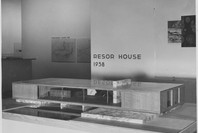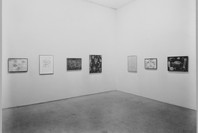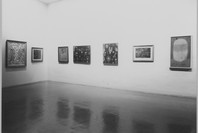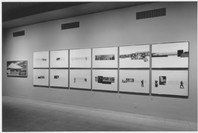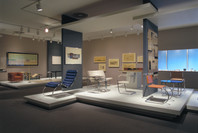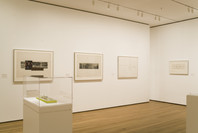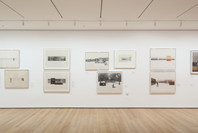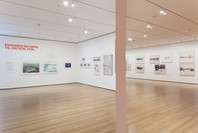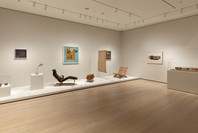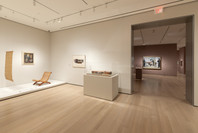This commission for a vacation house near Jackson Hole, Wyoming, in the Grand Teton Mountains, brought Mies van der Rohe to the United States for the first time, in 1937. These photocollages are a departure from the architect’s earlier photomontages. Instead of a composite image composed by cut–and–pasting different photographs, the photographic content is presented in dialogue with an architectural sketch. Rather than an external, urban scene, the nearly dematerialized architecture of the interior stages a view onto the surrounding landscape. The design is limited to spare horizontal lines that indicate the planes of floor and ceiling and slender cruciform columns that span between them. The overscaled and vividly textured landscape imagery was taken from film posters and magazines. It acts both as a visual extension of the architecture and an illusionistic space that distorts and rearranges the linear perspective of the drawing.
Gallery label from Cut ’n’ Paste: From Architectural Assemblage to Collage City, July 10–December 1, 2013.
In 1937, Ludwig Mies van der Rohe accepted an invitation to visit the United States for the purpose of designing a vacation home for Mr. and Mrs. Stanley Resor near Jackson Hole, Wyoming. The house was to span a stream that branched off the Snake River; the Grand Tetons loomed in the distance. By the next year Mies had emigrated to the United States to head the architecture school at the Illinois Institute of Technology, Chicago. Although the clients had lost interest in pursuing the project, Mies continued to revise the design and created a number of new drawings, including this collage. George Danforth and William Priestley, students of Mies's, produced the collage, which represents a view from the main living area to the landscape beyond.
In preparing his original design, Mies had made sketches showing freestanding elements—a bench facing the view, a long low cabinet defining the dining space, and a taller bookcase creating a reading area. The strip of wood veneer in the collage seems to be a vestige of the cabinet while the cutout of a painting (Paul Klee's Gay Repast, 1928) reflects the proportions of the bookcase. The disposition of these elements appears neither functional nor even literal, but rather suggests the flowing nature of the space Mies envisaged.
Mies had used collage as a presentation technique throughout his career, beginning with the Bismarck Monument Project of 1910. In many earlier instances he had used collage to construct more realistic views; this and other collages of the 1930s and "40s, however, are less pictorial, more evocative. Thus the photograph of the rugged mountain landscape collaged into the window frames, with cowboys on horseback, does not represent the actual view from the site but suggests what could be considered a fantasy view on the architect's part.
Publication excerpt from an essay by Terence Riley, in Matilda McQuaid, ed., Envisioning Architecture: Drawings from The Museum of Modern Art, New York: The Museum of Modern Art, 2002, p. 90.

